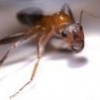
Went hiking in the Boise Foot Hills this morning. This is right around 5 Mile Creek. I went off path quite a bit as I'm new to the area and couldn't find the official trail until the return trip, so I ended up mostly walking along ridges until I reached the summit of the closest hill high enough to have a treeline.

It took quite a while to find any sign of ants, though I did find this horrific thing and a potential mate on the way up the first ridge.

I'm not exactly sure what these are...some sort of giant cricket. As the day got warmer they became very abundant. Only the males would bother getting out of the way, jumping quickly and chirping quite loudly while doing it. The females would just sit there and assume you weren't there to eat them. I wonder if they're extremely toxic as it was hard not to notice them.
Then I found these fellows!

The picture is kind of poor, but you can see the much larger female and two prospective suitors (I think). You can also see the zig-zag webbing that I remember reading keeps birds from flying through.
Finally some ants!

Though it took about an hour before it got warm enough to see any activity.

On the same mound I also found some tiny Pheidole pilfering debris. I'm not sure if it was seeds, sticks, rocks, or insect fragments.


I also must have just missed some flights by a few days or a week or two. This looks like the same kind of debris pattern that Pogonomyrmex queens make and I found several of them around. Could also be some other random insect though and I didn't bring a shovel to check.

A couple more ridges up, I spotted something in the grass.

Boot for scale. Kind of hard to tell but it's about 1.5 feet tall.


Of course with any mound building Formica in the desert, looking around in the bushes usually pays off. This was about 20 feet away from the nest.


Also observed but not photographed well enough: a small nest of some Aphaenogaster species, a squat and grey Formica species, and finally small black Crematogaster.
I had been hoping to find Myrmecocystus, but I suspect I'll have to go to the flatter valley floor to find them. At least the hike won't involve large changes in elevation.























